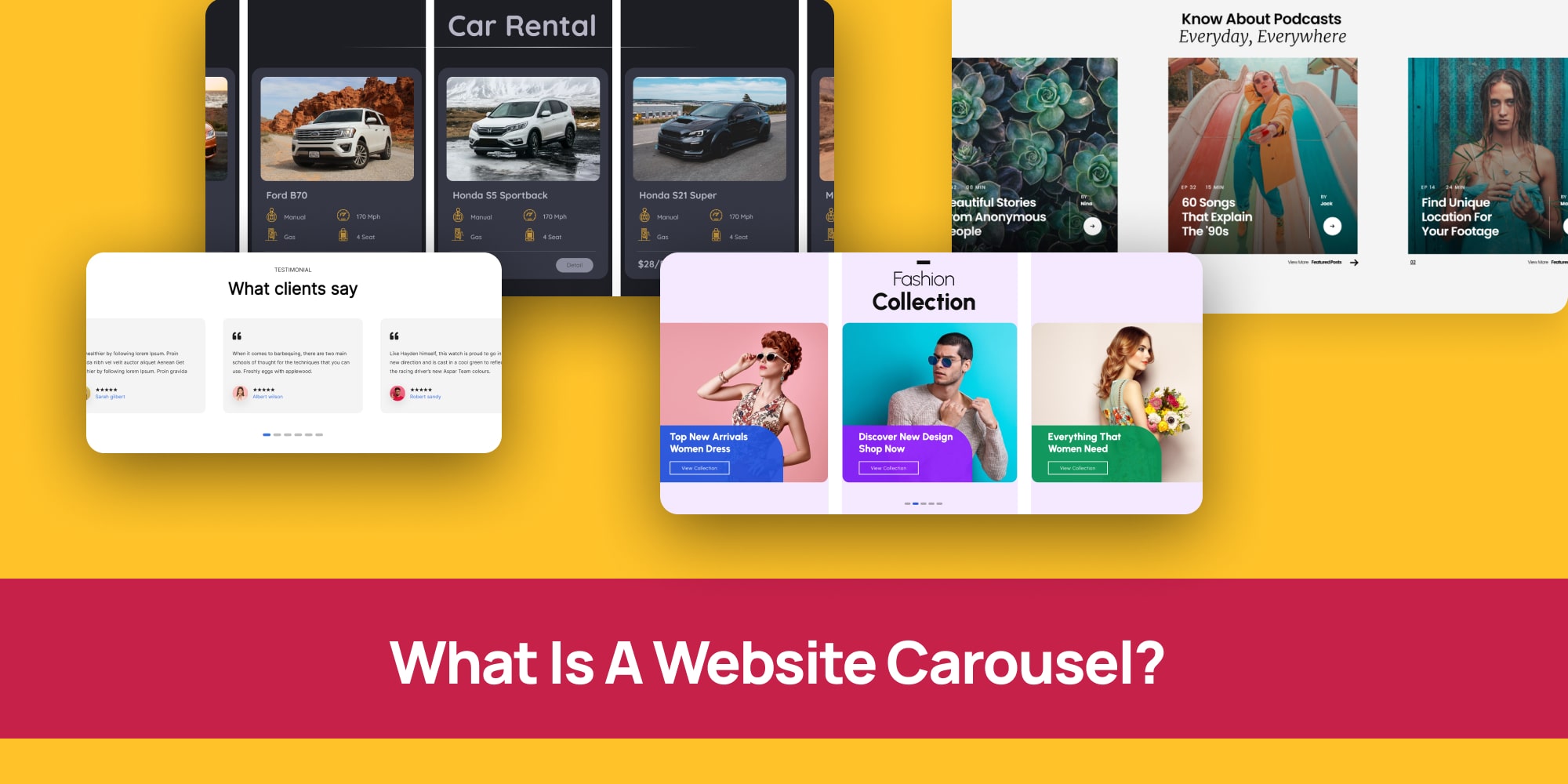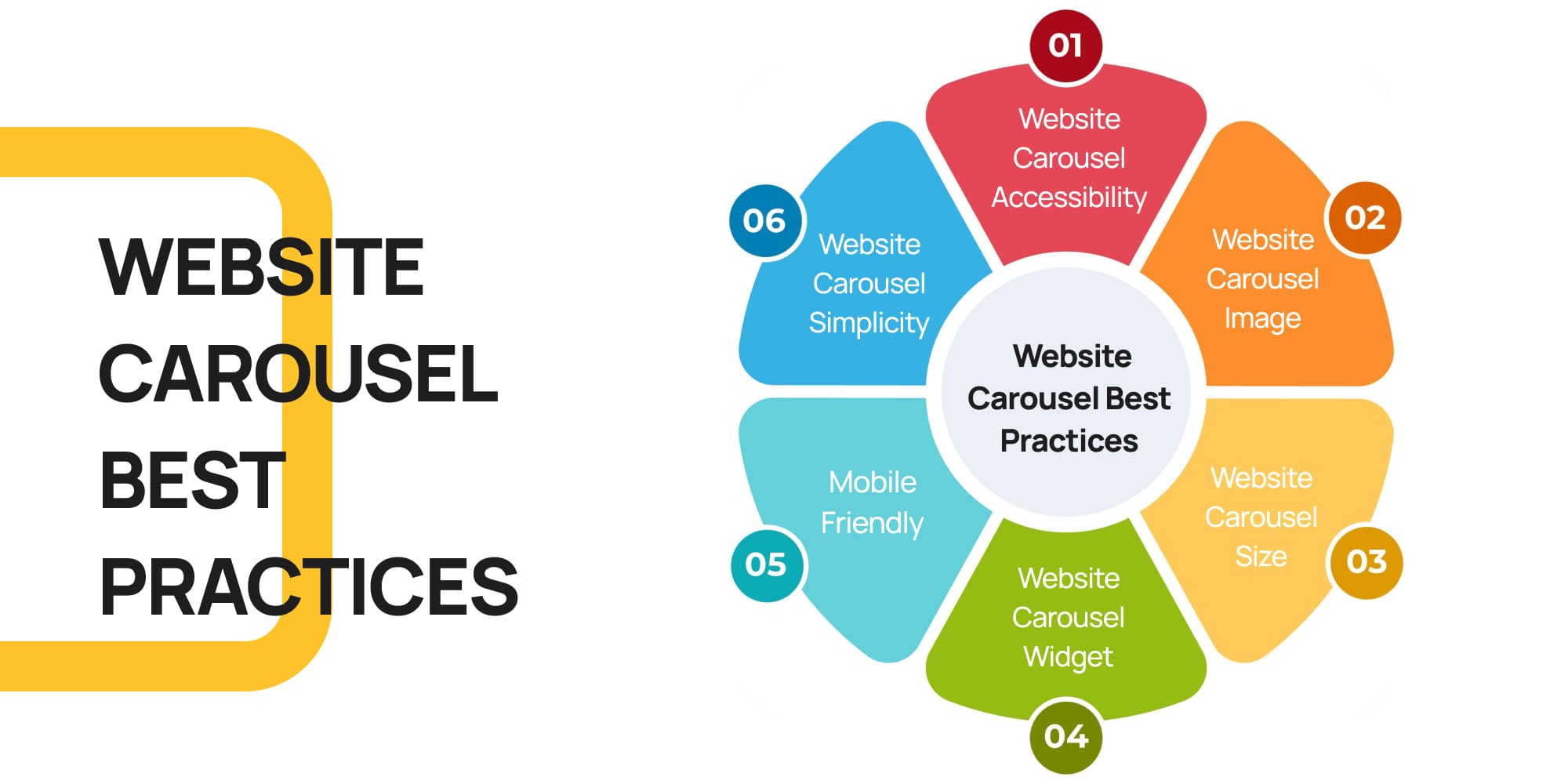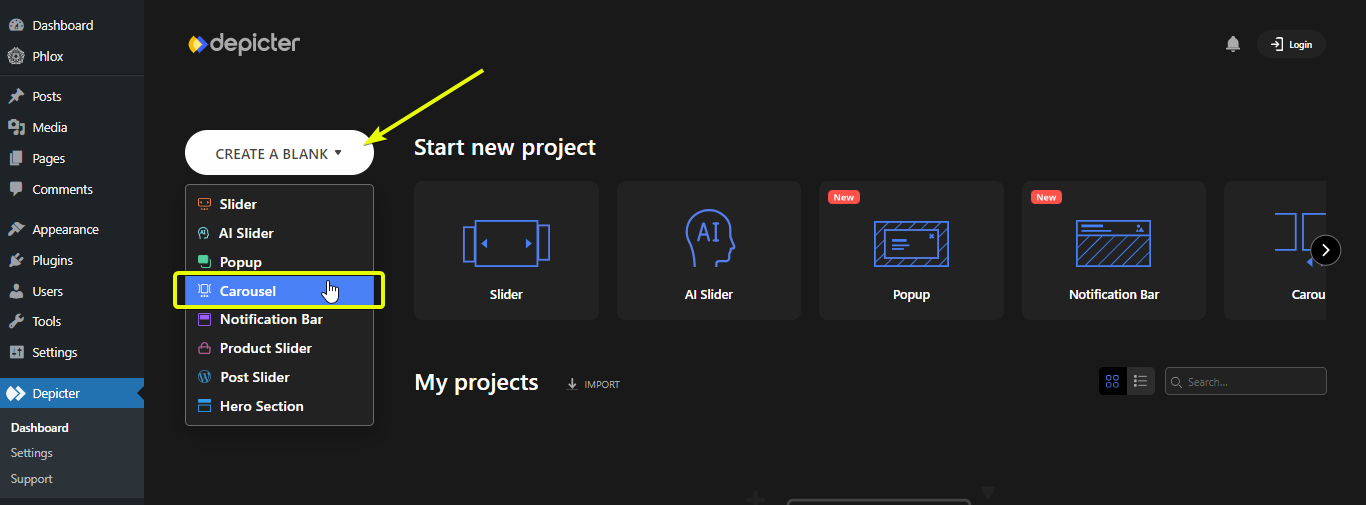Want to know what a website carousel is? Ever seen those swipeable sections on websites that show off cool pictures or info?
Those are called website carousels, kind of like a digital picture frame that keeps things fresh.
They’re a great way to grab attention and pack a lot of info into a small space.
In this guide, we’ll break down everything you need to know about website carousels.
We’ll cover what they are, why they’re awesome, how they’re different from sliders (don’t worry, it’s a minor detail!). and even show you some cool examples.
Plus, we’ll dive into some tips for designing killer carousels and creating your own (it’s easier than you think!).
So, buckle up and get ready to take your website to the next level!
Learn How to Create a Website Carousel From Scratch
No coding required!
In this video, you’ll learn how to create a website carousel from scratch using Depicter.
What is a Website Carousel?

Ever scrolled through a website and seen those cool, swiping images or videos?
Those are called website carousels, also known as carousel sliders. Think of them like multiple digital picture frames that show off different stuff all at once.
There are two main types:
- Automatic Carousels: These are like those fancy automatic photo booths at the mall. They change pictures on their own, showing you different things at a set speed.
- Manual Carousels: These are like flipping through a photo album. You use arrows on the side to control which picture you see.
Website designers love carousels because they’re like superheroes with two superpowers:
- Space Savers: They can showcase a bunch of cool stuff, like your favorite bands’ new albums or the top games to download, without taking up tons of space on the website.
- Attention Grabbers: They keep you hooked! Those swiping pictures are way more interesting than just plain text, right? This makes you more likely to stay on the website and check out what they have to offer.
So now you know what carousels are on a website, and you probably already know what a slider is on a website, but you can’t quite see the difference.
That’s alright, we’ll break down for you.
Website Carousel vs. Slider: What’s the Difference

You hear the terms “carousel” and “slider” thrown around when talking about websites. They both sound similar, right?
Well, you’re not wrong! Both carousels and sliders are like slideshows that show off images, videos, or other content on your website. You can often control them manually with arrows, or they can change automatically.
Here’s the small catch:
- Carousels: Imagine a merry-go-round for images. A carousel shows you several slides at once, like a little preview window.
- Sliders: Think of a single photo frame. Sliders only show you one slide at a time, and you click arrows (or don’t depending on the slider) to see the next one.
In the grand scheme of things, both carousels and sliders achieve the same goal – showcasing content. But the way they do it can be slightly different.
Don’t worry, though, no matter which you choose, they can be great tools to boost your website’s performance if used well!
Website Carousel Examples
Looking for website carousel examples to inspire your next website design?
Imagine a website for a clothing store. They could use a carousel on their homepage to showcase their latest fashion collections. Each slide in the carousel could display a different outfit with a clear call to action button like “Shop Now!”
Carousels aren’t just for pictures, though! An architect might use a carousel to show off photos of their completed projects, one beautiful building at a time.
Depicter Comes With Many Website Carousel Templates!
Let’s take a look at some website carousel templates to inspire you in your website design.
Grocery Carousel
Imagine a grocery store website using a carousel to display their weekly specials. Mouthwatering photos of fresh fruits, vegetables, and delicious treats would grab your attention right away!
Fashion Trends Carousel
A clothing store could use a carousel to highlight the latest trends. They could show off trendy outfits or new arrivals, making it easy for you to discover the hottest styles.
Brands Carousel
Companies often use carousels to display logos of their trusted partners or collaborators. This builds trust with visitors and shows the strength of their brand network.
Company Testimonial Carousel
Testimonials are a great way to showcase positive feedback from satisfied customers. A carousel can display these testimonials, one at a time, letting visitors see what others are saying.
Podcast Box Carousel
Podcasters can use carousels to feature their latest episodes. Eye-catching graphics and short descriptions can entice visitors to tune in and listen.
Clean Testimonial Carousel
Similar to testimonials, carousels can be used to display positive quotes or reviews from happy clients. This adds social proof and builds trust with potential customers.
Web Page Carousel Examples: In Action
You’ve seen some web page templates above that you could use in your website.
Let’s take a look at some Real Websites using carousels on their webpages to inspire you in your design.
Silkool Tomiko
Imagine planning a trip to Tomioka City! The official tourist information website, Silkool Tomiko, might use a carousel to showcase stunning photos of the city’s must-see attractions. Each slide could feature a different landmark, like a beautiful temple or a serene garden, tempting you to explore further!
MAENI
Maeni, a manufacturing company, wants to show off the cool things they make. Their website might have a unique carousel where the items seem to move based on a slider bar. As you adjust the slider, the carousel animates, giving you a 360-degree view of their products in a fun and interactive way!
Arte
Feeling indecisive about what to watch? Arte, a popular TV channel, might use a carousel to highlight their latest documentaries, films, and other programs. Each slide could display a captivating image and a short description of the show, making it easy to discover something new and interesting to tune into.
Gravis
Looking for the latest iPhone or MacBook? Gravis, an online Apple product store, might use a carousel to showcase their hottest deals. Imagine swiping through images of sleek Apple devices, each with a clear “Buy Now” button, making it a breeze to grab the gadget you desire.
Apple
Apple’s official website might use a carousel on their Mac page to convince you they’re the best place to buy a Mac computer. Each slide could highlight unique features of Macs, like their stunning displays or powerful performance, making a compelling case for why you should choose Apple.
Ikea
Ikea isn’t just about furniture! Their website might have a carousel featuring articles with tips on how to treat yourself right, every day. Imagine swiping through ideas for a relaxing bath, a cozy reading nook, or a delicious home-cooked meal, inspiring you to create a little everyday oasis in your own home.
Quick Tips: Website Carousel Best Practices

Here are some handy tips to make sure your website carousel is both beautiful and easy to use for everyone.
Imagine you’re designing a storefront window – you want it to be attractive and grab people’s attention, but also clear and easy to understand.
The same goes for your website carousel! Here’s how to achieve that:
1. Website Carousel Accessibility
Imagine someone is visiting your website for the first time. Is it clear what each slide is about, and how to navigate the carousel? Here’s what you can do:
- Clear Structure: Build the carousel like a well-organized box, with each slide having a clear purpose. This helps everyone understand what’s there.
- User Control: Let people navigate the carousel at their own pace. This means including buttons to move forward and backward, and the ability to pause any animations.
- Easy to See: Make sure the colors and text are easy to read against the background, just like a well-lit shop window!
2. Website Carousel Image
People are drawn to visuals, so use high-quality images that are relevant to your message. Think of them as eye-catching headlines for each slide.
3. Website Carousel Size
Don’t make your carousel too big or too small. It should be a comfortable size that fits well on your webpage and doesn’t overwhelm visitors.
4. Website Carousel Widget
Many website builders, like WordPress, have plugins that make creating carousels a breeze. We recommend Depicter, a user-friendly website carousel WordPress plugin that lets you customize your carousel with ease.
5. Mobile Friendly
Remember, many people browse websites on their phones. Make sure your carousel looks good and works smoothly on all devices, not just computers.
6. Website Carousel Simplicity
Avoid cramming too much text or information onto each slide. People won’t have time to read a whole paragraph, so focus on a clear message and a strong image.
Website Carousel Tutorial: Easy as Pie!

Imagine adding a cool carousel to your website, but maybe coding sounds a bit tricky. Here’s where website carousel plugins come in!
These are like handy tools that help you create carousels without needing to be a programming whiz.
For WordPress websites, a popular option is the Depicter plugin. Think of it like a carousel building kit!
Depicter makes creating carousels super easy, with website carousel templates, drag-and-drop features and tons of customization options.
So you can add your own images, text, and choose a design that perfectly matches your website’s style.
And the good news is, we’re going to teach you step by step how to create and add a website carousel to your website in the next section of this guide!
Step 1: Installing and activating the Depicter Plugin
Before anything else, once your website is ready, in WordPress dashboard, head to plugins and click on “Add New Plugin“, then search for “Depicter“.
Once you find it, click on “Install Now“, and once installed, click “Activate“.

Step 2: Creating your Carousel
In this step you have two options; you can either choose one of the pre-made website carousel template and edit it, or you can create your carousel from scratch.
In this tutorial we’ll explain both.
a) Creating a Carousel Using a Pre-Made Carousel Template:
In the Depicter dashboard, either choose the carousel category or search “carousel” in the search bar.
Carousel templates will appear, if you see a carousel template that you like, import it!
Once imported, customize the carousel, and you’re good to go.
b) Creating a Carousel From Scratch
In the WordPress dashboard, head to Depicter. There are lots of pre-made carousel templates as you saw in the previous section.
But if you have something special in your mind, you can start creating your own carousel from scratch and we’ll help you with that.
So head to “CREATE A BLANK” on the left and choose “Carousel“.

Choose a name, and adjust the width and height of your carousel and start designing.
Once you’re done designing, publish your carousel so you can add it to your website.
Step 3: Adding the Carousel to your WordPress Website
Adding a carousel to your website is easy, all you have to do is;
Find your home-page or whatever page that you want to place your carousel at (either in “Pages” or by directly going to that page), and click on “Edit with Elementor.”

Once you’re in the Elementor editor page, create a section and add the Depicter widget to it, then choose the carousel that you have created.
Click on update whenever you’re ready and you’re done.
Easy as pie!
And that’s it, only in three steps, you’ve learned how to create and add a carousel to your web page using the best widget possible; Depicter!
Conclusion: Level Up Your Website with Website Carousels!
So, there you have it! You’ve learned everything you need to know about website carousels. We covered what they are, how they can boost your website, and even cleared up the mystery of “carousel vs. slider.”
We also explored some inspiring website carousel examples to spark your creativity. From showcasing your latest fashion collection to featuring glowing client testimonials, carousels offer a versatile way to grab attention and pack a punch.
Remember, using website carousel templates and user-friendly plugins like Depicter makes creating stunning carousels a breeze, even if you’re not a coding pro.
Here are some key takeaways to keep in mind:
- Website carousel best practices: Keep it clear, accessible, and mobile-friendly. Use high-quality images and focus on a strong message for each slide.
- Website carousel size: Choose a comfortable size that fits your website’s layout.
- Website carousel widget: Explore website builder plugins like Depicter to create and customize carousels with ease.
With a little planning and the right tools, you can easily add website carousels to your website and take your user experience to the next level. Now that you’re armed with this knowledge, get ready to create eye-catching carousels that will leave a lasting impression on your visitors!


Leave a Comment